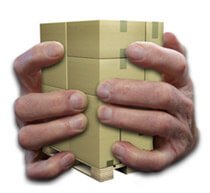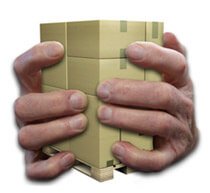Is There a Problem?
There seems to be a widely held belief that the ASTM has endorsed a particular method and particular tool to measure the containment force of stretch wrapped pallet loads. Believers often cite ASTM D4649 Standard Guide for Selection and Use of Stretch Wrap Films as the authority for this contention, particularly its Annex A1.

Annex 1A shows examples of tools that can be used to determine film force (equivalent to containment force) using the pull plate method and wrap-in scale method.
The fact is that the ASTM has NOT published any recommendation, approval, or method standard for these tools or, for that matter, any other containment force tools.
Additionally, the Guide specifically states “The test methods in Annex A1 are not ASTM standards. . .” (Par 12.1).
In case you’re wondering, ASTM is the acronym for the American Society for Testing and Materials International. Its business is the development and delivery of voluntary consensus standards. But in and of themselves, ASTM standards are not mandatory and don’t carry the force of government regulations or laws.
So Why Should You Care?
Because containment force is a big deal. It is one of the three key stretch wrapping metrics and is the best predictor of the safe arrival of a pallet load at its destination. Knowing that you have enough containment force everywhere on your load is a key stretch wrapping success factor. So the ability to accurately and consistently measure containment force is essential.
Because as Peter Drucker famously said “If you can’t measure it, you can’t improve it.” When it comes to containment force we think it should be “If you can’t measure it accurately, you can’t improve it.”
And therein lies the crux of the problem.
Today, there are least four generic commercially available types of containment force tools:
- Pull plate
- Wrap-in scale
- Pull bar
- Dual finger
They vary widely in ease of use, consistency, and accuracy. Lantech has extensive experience with all four. We recommend that the first three be used in lab environments where there’s assurance that highly skilled technicians can use them on a precisely flat sided (box) load and where containment force on the middle and bottom of the load may not be important.
The dual fingered type tool (Lantech’s CFT-5) was designed as a plant tool to be used in the field to measure the containment force on actual loads and does not depend on a flat load side or highly skilled and motivated operators for its accuracy. This tool is easy to use, fast, accurate, and consistent. It works equally well at the top, middle, and bottom of the load and is nondestructive (no re-wrapping of the load required after measurements are taken).
Containment force is measured at the top, middle, and bottom of a load and is expressed in pounds (or kilograms). So we would say, “The containment force on a particular load is seven pounds at the top, seven pounds at the middle, and nine pounds at the bottom.”
So, how much containment force should a load have? Here are some rules of thumb that are useful for doing quick checks. These rules are based on a large sampling of actual field audits as opposed to theoretical simulation testing.
Load Type – light – paper towels – 2-4 pounds
Load type – stable – cartons, bags, or trays – 5 – 7 pounds
Load type – unstable – beverages, full bottles – 8-12 pounds
Load type – very unstable – shrink wrapped water bottles – 12-20 pounds
Note: The containment force rules of thumb are not a short cut or a substitute for developing containment force standards for individual loads! But, in the absence of good empirical data, they can serve as a good starting point for developing an effective containment force profile.
Normal containment force should be relatively even from the top to the bottom of the load unless there is a clear reason for a difference. For Example, crushable display cartons may require a lower containment force on the top layer of product.
Many loads require extra containment force to bond the load to the pallet. We typically recommend 10-30% more containment force at the bottom of most loads for that reason. We recommend a film rope just under the top deck of the pallet to insure it is not ruptured by the fork truck.
A Warning About Containment Force
Containment force should be considered along with the other two specification elements of an effectively wrapped load. These other elements are the bond of the load to the pallet and no dragging film tails.
Loads can be wrapped with virtually any combination of film and machine settings that produce the desired containment force. Film selection and machine settings should then be iterated for the lowest cost……while maintaining desired containment force.
What’s Ahead?
Lantech has recently joined the ASTM Task Committee responsible for revising ASTM D4649 Guide. We have recommended that all four generic tool types be listed in Annex 1A. We’re confident that the ASTM guide will be modified at some point in the near future clarifying the ASTM status of all of these tools.
Until then, use good judgment. Understand the limitations of whatever containment force tool you use and, above all, do your best to operate it consistently.
Click here to see how to use a CFT-5 Containment Force Tool.
Here is a video showing the use of our recommended containment force tool.
Check out the containment force tools page.
You may be interested in these posts on containment force:
- How to Figure Out the Right Containment Force for Your Loads
- Do You Know the Golden Rule of Containment Force?
- Use The Force: Containment Force Is The Key to Safe Pallet Loads
This post was published on April 12, 2017 and updated on July 6, 2017.
April 12, 2017

